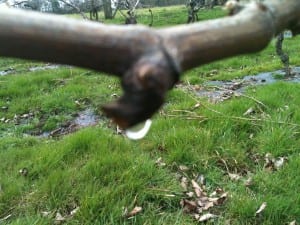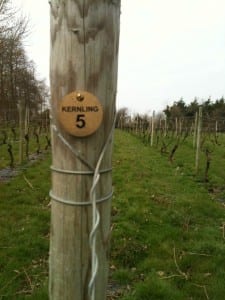Tying Down at Oatley
Of course the sun is out as I approach Oatley! I’m greeted by Jane who shows me the new 2010 wine that arrived, it was really great to see as I had been part of the process of picking the grapes along with many other volunteers including my nieces and Matthew.
A smaller cage sat along side the bottles of Madeline Angevine and Kernling and that was the wine that had been maturing in the new oak barrel. The wine chosen for barrel maturation was the Madeline Angevine. Jane had tasted it and said “subtle vanilla from the toasted oak, adds mid palate and finish but without swamping.” I’m looking forward to purchasing a bottle or two.
The next job in the vineyard was tying down the canes that we had pruned in previous weeks. You have to wait for the sap to rise to make the canes flexible to enable you to do this process.
Iain showed me what to do, how you carefully ease the cane down and place it around the lower wire to hold it in place. Not all canes can be held in place by their natural shoots holding on to the wire so we use little plastic grips. Something so easy gave me so much trouble! I had to have a lesson from Iain solely on a plastic clip, not one of my finer moments.
The row of vines I’m looking after is K5. The first vine of tying down went well I had a sigh of relief, my second vine there was a snap, off came a cane, it makes you feel sick knowing that you have just halved that vines potential of producing grapes. More concentration and ease with the vine I don’t want to make that mistake again. The same principle applies to tying down as pruning in that you have to take in to account the next vine as well as the one your working on to make sure the vines flow all the way down the row.
Its important at Oatley that the canes and buds don’t overly lap so that the grapes have their own space for light and air to circulate to reduce the potential mildew. This shows the great care taken to make the wine and that quality is paramount and not quantity.
Having pruned and tied down the process makes much more sense. You can see how one stage leads on to the the next and how each stage is critical in its own right. Books are great but nothing beats the hands on practical approach and watching the process evolve before you.
Over the past few visits I have worked on the Kernling Grape whereas next time I’ll be learning about the Madeline Angevine pruning as this is a different style and needs to be left as long as possible for reasons I will explain.




No comments yet.